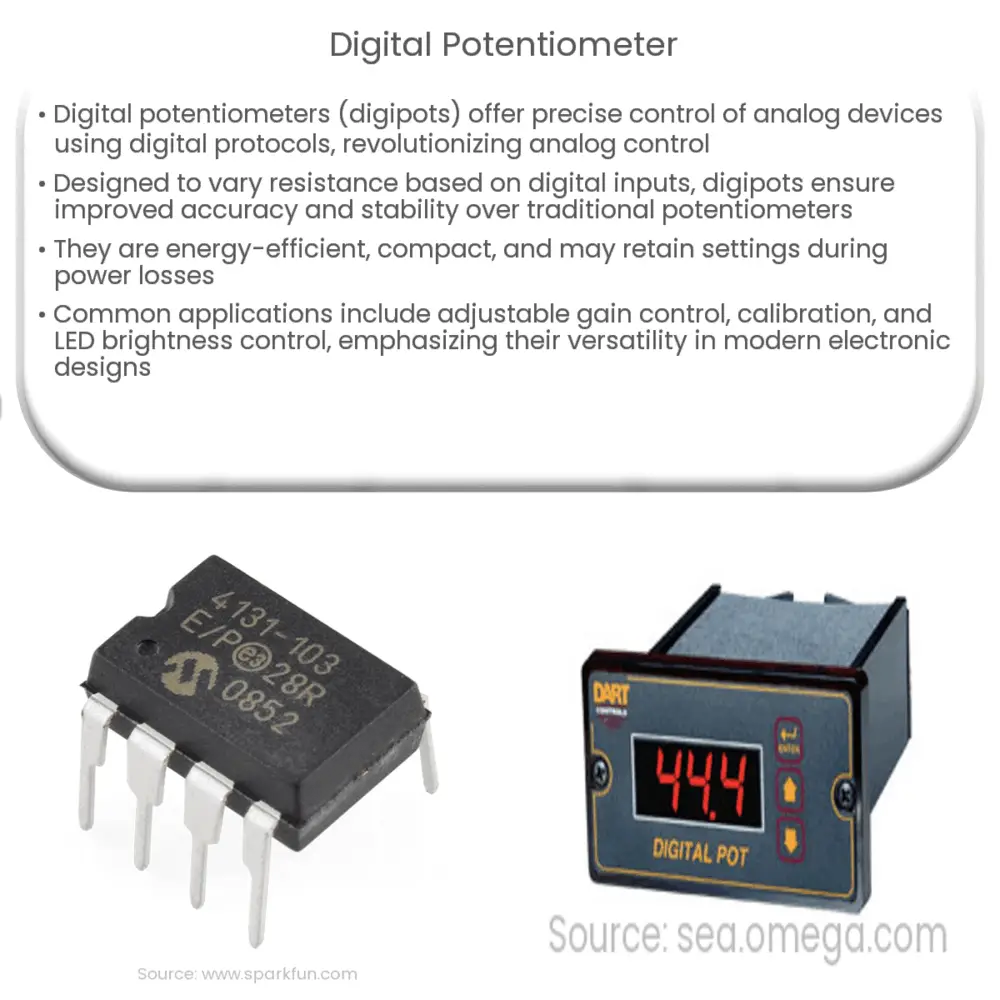Digital potentiometers offer precise analog signal control, with advantages like improved accuracy, reduced size, and lower power consumption.

Digital Potentiometer: Revolutionizing Analog Control in the Digital World
As the world of technology evolves, new and innovative ways of handling analog signals are being developed. One such solution is the digital potentiometer, which offers precise control of analog devices and circuits using digital protocols. In this article, we will explore the basic principles of digital potentiometers, their applications, and their benefits over traditional analog potentiometers.
What is a Digital Potentiometer?
A digital potentiometer, also known as a digipot, is an electronic device that simulates the function of an analog potentiometer. It is designed to control analog signals with digital precision by varying its resistance in response to digital inputs. Essentially, it serves as an adjustable resistor, whose resistance value can be changed by a digital signal or command, offering improved accuracy and stability over its analog counterpart.
How Does a Digital Potentiometer Work?
Digital potentiometers are typically constructed using complementary metal-oxide-semiconductor (CMOS) technology, which enables the creation of highly integrated devices with low power consumption. A digital potentiometer consists of an array of resistive elements connected in series, a set of electronic switches, and a digital interface that provides control signals to the switches.
The resistance value of a digital potentiometer is adjusted by selecting different combinations of resistive elements in the array through the activation or deactivation of the electronic switches. This selection process is determined by the digital control signals received from the digital interface, such as an SPI, I2C, or other serial communication protocol.
Advantages of Digital Potentiometers over Analog Potentiometers
There are several advantages that digital potentiometers offer over traditional analog potentiometers. Some of these benefits include:
- Improved Accuracy: Digital potentiometers can provide a higher resolution for resistance adjustment, resulting in more accurate control of analog signals. This increased accuracy also means better performance and stability in various applications.
- Non-Volatile Memory: Some digital potentiometers are equipped with non-volatile memory, which retains the last resistance setting even when power is removed from the device. This feature can be beneficial in applications where the potentiometer’s setting must be maintained during power loss or system resets.
- Reduced Size and Weight: Due to their digital nature and the use of integrated circuits, digital potentiometers can be significantly smaller and lighter than traditional analog potentiometers. This reduction in size and weight makes them ideal for use in compact or portable electronic devices.
- Lower Power Consumption: Digital potentiometers typically consume less power than their analog counterparts, making them a more energy-efficient choice for many applications.
Applications of Digital Potentiometers
Digital potentiometers have a wide range of applications across various industries. Some common uses include:
- Adjustable Gain Control: Digital potentiometers can be used to control the gain of operational amplifiers in audio and instrumentation applications, allowing for precise adjustments and improved signal quality.
- Programmable Voltage Reference: In power supply and data converter applications, digital potentiometers can be employed to create an adjustable voltage reference, enabling fine-tuning of the output voltage.
- Calibration and Tuning: Digital potentiometers can be utilized for calibrating and tuning analog circuits, such as filters and oscillators, ensuring optimal performance and stability.
- LED Brightness Control: Digital potentiometers are used to control the current through an LED, allowing for precise adjustments of brightness levels in lighting applications.
Selecting the Right Digital Potentiometer
When choosing a digital potentiometer for your application, there are several factors to consider:
- Resolution: The resolution of a digital potentiometer determines the smallest incremental change in resistance it can provide. Higher resolution devices offer more precise control but may also require additional power and cost more.
- Interface: Digital potentiometers use various communication protocols, such as SPI, I2C, or UART. Selecting the appropriate interface for your application will ensure seamless integration with your existing hardware and software.
- End-to-End Resistance: The total resistance of the digital potentiometer, also known as its end-to-end resistance, should match the requirements of your application. Common values include 1kΩ, 10kΩ, 50kΩ, and 100kΩ, among others.
- Operating Voltage: It’s essential to choose a digital potentiometer with an operating voltage range compatible with your system’s voltage requirements.
- Temperature Range: Ensure that the device’s specified operating temperature range matches the environmental conditions of your application.
Conclusion
Digital potentiometers offer numerous advantages over traditional analog potentiometers, including improved accuracy, reduced size and weight, and lower power consumption. As a result, they have become an essential component in various applications, such as adjustable gain control, voltage reference, calibration, and LED brightness control. By understanding the basic principles, advantages, and selection criteria for digital potentiometers, you can make an informed decision when incorporating this versatile device into your electronic design.

